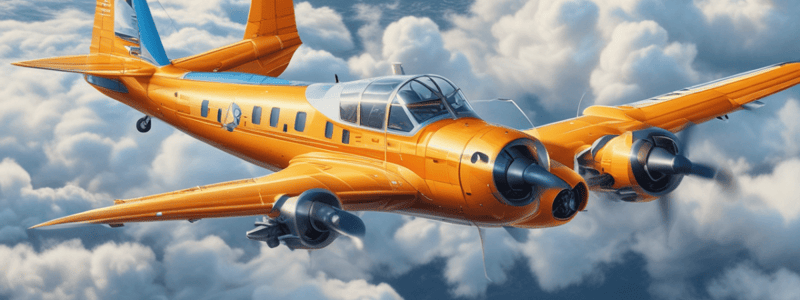Podcast
Questions and Answers
What are the two separate and independent actuators that control the rudder?
What are the two separate and independent actuators that control the rudder?
EHSA (Upper actuator) and EBHA (Lower actuator)
What does the EBHA actuator consist of?
What does the EBHA actuator consist of?
An EHSA-type hydraulic part combined with local Motor Control Electronics (MCE)
Where is the EBHA REU mounted?
Where is the EBHA REU mounted?
Directly to the hydraulic actuator manifold
What are the two power sources for the EBHA actuator?
What are the two power sources for the EBHA actuator?
What are the two hydraulic manifolds in the EBHA actuator?
What are the two hydraulic manifolds in the EBHA actuator?
In normal operation, how are the two actuators configured for rudder control?
In normal operation, how are the two actuators configured for rudder control?
What provides power to the EBHA actuator?
What provides power to the EBHA actuator?
What components provide data to the REUs to activate the actuators?
What components provide data to the REUs to activate the actuators?
How many dissimilar hardware lanes does the REU have for integrity control?
How many dissimilar hardware lanes does the REU have for integrity control?
What is the purpose of the rudder control in an aircraft?
What is the purpose of the rudder control in an aircraft?
Study Notes
Rudder Control Module
- Located above the floor, forward of the pedestal
- Connected to both pilot and copilot rudder pedals
Rudder Cockpit Sensors
- Five RVDT sensors in the RVDT cluster on top of the rudder control module
- Translate mechanical movement into electronic signals provided to the FCCs
- Provide data to:
- FCCs
- BFCU
- Autopilot system
- Flight data recorder
Hydraulic Actuation
- FCCs provide position signals to REUs to operate rudder hydraulic actuators
- Hydraulic pressure to actuators passes through hydraulic manifolds and is controlled by REUs
- Actuators are powered by left and right hydraulic system engine-driven pumps during normal operation
Rudder Control System
- Provides rudder control, fault monitoring, and CAS notification
- Part of the primary Flight Control System (FCS)
- Rudder control surface is located vertically on trailing edge of vertical stabilizer
- Rudder deflection is ±25° ±1° left and right
Subsystems
- Rudder Interface and Control
- Cockpit Sensors
- Hydraulic Actuation
- System Electronics
Rudder Interface and Control
- Conventional pilot and copilot rudder pedals provide inputs to rudder RVDT position sensors
- RVDT position sensors provide data to FCCs and BFCU
- FCCs send data on Bidirectional ARINC 429 (BD429) digital data buses to REUs
- REUs command hydraulic actuators to move the rudder
Actuators
- Rudder is controlled by two separate and independent actuators:
- EHSA (Upper actuator)
- EBHA (Lower actuator)
- EBHA actuator has a dual power source: Hydraulic and Electric
Studying That Suits You
Use AI to generate personalized quizzes and flashcards to suit your learning preferences.
Related Documents
Description
Learn about the location and function of the rudder control module in an aircraft. Discover how pilot and copilot rudder pedals are connected to the module, and the sensors involved in translating mechanical movement to electronic signals.



